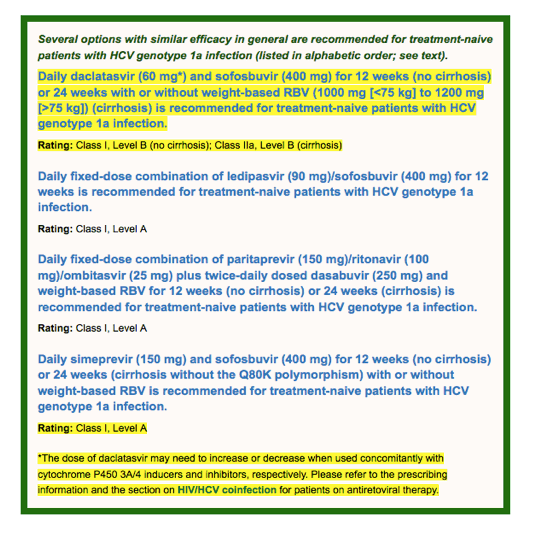| |
Updated HCV Guidelines: treatment update & "supports treatment for all HCV-infected persons"
|
| |
| |
HCVguidelines.org
UPDATED - INITIAL TREATMENT OF HCV INFECTION
http://hcvguidelines.org/full-report/initial-treatment-hcv-infection

WHEN AND IN WHOM TO INITIATE HCV THERAPY.......http://hcvguidelines.org/full-report/when-and-whom-initiate-hcv-therapy
"........Evidence clearly supports treatment for all HCV-infected persons, except those with limited life expectancy (less than 12 months) due to nonĞliver-related comorbid conditions. Although treatment is best administered early in the course of the disease before fibrosis progression and the development of complications, the most immediate benefits of treatment will be realized by populations at highest risk for liver-related complications. Thus, where resources limit the ability to treat all infected patients immediately as recommended, it is most appropriate to treat first those at greatest risk of disease complications and those at risk for transmitting HCV or in whom treatment may reduce transmission risk. Where such limitations exist, prioritization of immediate treatment for those listed in Tables 3 and 4 is recommended, including patients with progressive liver disease (Metavir stage F3 or F4), transplant recipients, or those with severe extrahepatic manifestations."
"Cure of HCV infection also reduces symptoms and mortality from severe extrahepatic manifestations, including cryoglobulinemic vasculitis, a condition affecting 10% to 15% of HCV-infected patients. (Fabrizi, 2013); (Landau, 2010) HCV-infected persons with non-Hodgkin lymphoma and other lymphoproliferative disorders achieve complete or partial remission in up to 75% of cases following successful therapy for HCV infection. (Gisbert, 2005); (Takahashi, 2012); (Svoboda, 2005); (Mazzaro, 2002); (Hermine, 2002) These reductions in disease severity contribute to dramatic reductions in all-cause mortality. (van der Meer, 2012); (Backus, 2011) Lastly, patients achieving SVR have substantially improved quality of life, which includes physical, emotional, and social health. (Neary, 1999); (Younossi, 2013) Because of the myriad benefits associated with successful HCV treatment, clinicians should treat HCV-infected patients with antiviral therapy with the goal of achieving an SVR, preferably early in the course of their chronic HCV infection before the development of severe liver disease and other complications. Recent reports suggest that initiating therapy in patients with lower stage fibrosis may extend the benefits of SVR. In a long-term follow-up study, 820 patients with Metavir stage F0 or F1 fibrosis confirmed by biopsy were followed for up to 20 years. The 15-year survival rate was statistically significantly better for those who experienced an SVR than for those whose treatment had failed or for those who remained untreated (93%, 82%, and 88%, respectively; P =.003). The study argues for consideration of earlier initiation of treatment (Jezequel, 2015). Several other modeling studies suggest a greater mortality benefit if treatment is initiated at stages prior to F3. (¯vrehus, 2015); (Zahnd, 2015); (McCombs, 2015)"
Benefits of Treatment at Earlier Fibrosis Stages (Metavir stage < F2)
Treatment delays may decrease the benefit of SVR. In a report of long-term follow-up in France, 820 patients with biopsy-confirmed stage F0 or F1 were followed for up to 20 years. (Jezequel, 2015) The authors noted 15% rapid progression of fibrosis, and in those patients treated successfully long-term survival was better. Specifically, at 15 years, survival was 92% for those with an SVR versus 82% for treatment failures and 87% for those not treated. In a Danish regional registry study, investigators modeled treatment approaches with the aim to evaluate the benefit to the region in terms of morbidity and mortality reductions and HCV prevalence. (¯vrehus, 2015) Although they note that in their low HCV prevalence (0.4%) situation, with approximately 50% undiagnosed, a policy that restricts treatment to those with Metavir fibrosis stage F3 or higher would decrease mortality from hepatocellular carcinoma (HCC) and cirrhosis, the number needed to treat to halve the prevalence of the disease is lower if all eligible patients receive treatment at diagnosis. A modeling study based on the Swiss HIV cohort also demonstrated that waiting to treat HCV at Metavir fibrosis stages F3 and F4 resulted in 2- and 5-times higher liver-related mortality, respectively, compared with treating at Metavir stage F2. (Zahnd, 2015)
A US Veterans Administration dataset analysis by McCoombs and colleagues, using very limited end points of virologic response dating from the IFN era, suggested that early (at a FIB-4 score of <3.25) initiation of therapy increased the benefit attained with respect to likelihood of treatment success, mortality reduction, and ultimately decreased the number of patients needed to treat to preserve 1 life by almost 50%. (McCombs, 2015)
Other populations at high risk for liver disease progression (such as Metavir stage F2 or HIV-1 coinfection) (Table 1) are also expected to garner appreciable benefits, although the time course for realizing these benefits may be more protracted.
SVR will also remove the risk of further transmission. Treatment of individuals at high risk to transmit HCV to others (Table 2) may yield long-term future benefits from decreased transmission and a potential decrease in HCV disease prevalence.
|
|
| |
| |
|
|
|